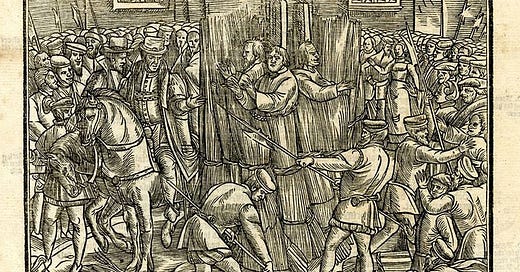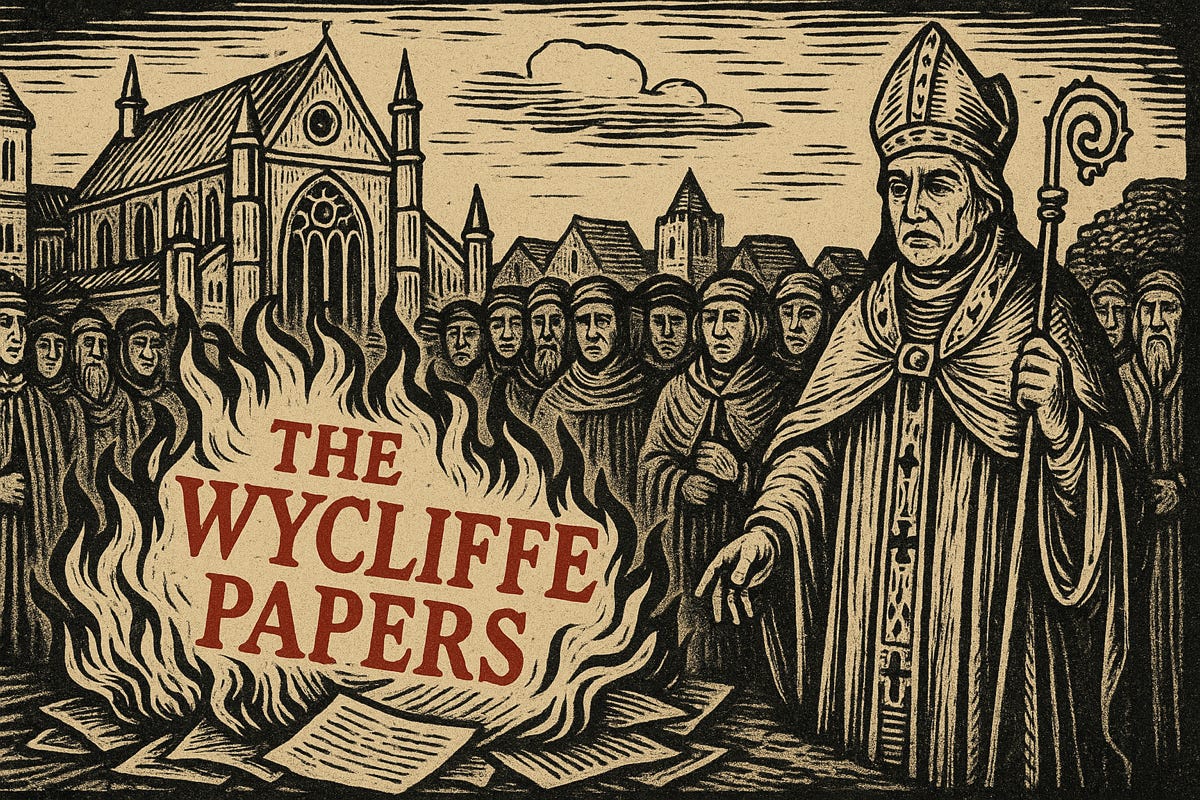Saints, Martyrs and Equal Opportunity Violence
A modest proposal for a commemoration for the Church of England
The Wycliffe Papers launched on 1st May: jokes for those who are serious about the Bible. More info below.
On 4th May, the Church of England commemorates the Saints and Martyrs of the English Reformation.
To an evangelical (like me) this looks like a day of remembering the heroes of the faith who were burned by Queen Mary and all of those we find in Foxe’s Acts and Monuments (more commonly known as Foxe’s Book of Martyrs). In your mind, you might be galloping off to the White Horse Tavern in Cambridge, thinking of those reformers in the backroom talking about Luther’s stand against Rome, reviving all kinds of ideas about the banned teachings of Wycliffe.
Hold your white horses.
The use of the word ‘Saints’ in the title of this day should be a tell. Do some digging and you will find this date of commemoration is not included in the 1662 Book of Common Prayer. It has snuck onto the Church of England’s calendar recently. Also note that the Catholic Church in England and Wales also remember Saints and Martyrs on 4th May. Here’s why:
On 4 May 1535, three Carthusian monks—John Houghton, Robert Lawrence, and Augustine Webster—were executed at Tyburn in London, becoming some of the earliest Roman Catholic casualties of the English Reformation. They were not burned for heresy. They were hung, drawn and quartered for treason. They would not swear allegiance to the King of England as the head of the Church of England, thereby renouncing their loyalty and obedience to the Pope. And so they were branded traitors and executed.
All three men were priors of Carthusian religious houses: Houghton, Prior of the Charterhouse in London; Lawrence, Prior of Beauvale in Nottinghamshire; Augustine Webster, Prior of Our Lady of Melwood at Epworth in North Lincolnshire. They had come to prominence because the monasteries were in the process of being dissolved.
Houghton, said to have forgiven his executioners and reaffirmed his fidelity to Catholic doctrine before his death, was the first of “Forty Martyrs of England and Wales” to be beatified by Pope Leo XIII in 1886, and then canonised by Pope Paul VI in 1970. By the year 2000, attitudes to Roman Catholicism and their martyrs had changed in England so we now have 4th May in our calendars as the Saints and Martyrs of the English Reformation.
Perhaps we should at least be grateful that the Church of England has not fully succumbed to the spirit of the age and dedicated the day to St Yoda, since “May the Fourth” (be with you) is also a day recognised by fans of Star Wars.
A Contested Past
The fact is that the Church in England was connected to Rome for nearly a thousand years. That is a long time by anyone’s reckoning (except to the Lord, of course. It’s like a day to him.). In fact, our Church was Roman for twice as long as not. Those who make the case that the Church of England is a Reformed Catholic faith, as the Oxford Movement did in the 19th century, have a point.
Reformed evangelicals (like me) would argue that something happened in the 16th century that fundamentally altered the Church of England. It was more than a change in governance. It was a change of theology looking back to the New Testament and the Early Church Fathers, rather than the mission from Rome in 597.
By the end of the 16th century, England was firmly, publicly and mostly privately Protestant. These convictions were entrenched by a series of wars against Catholic Spain and France who seemed to do the evil bidding of the Pope in Rome. This undoubtedly grieved the hearts of many loyal Englishmen who also believed in Papal authority and transubstantiation.
So here is the problem: both Reformed Evangelicals like me and Reformed Anglo-Catholics claim to the legitimate heirs of the historic Church of England. How can we remember, celebrate, commemorate and commiserate its chequered and, ahem, theologically diverse history?
A New Festival of Unity
Here’s a suggestion: a new festival to be held on 30th July commemorating the events of 30th July 1540 in Smithfield. On that day King Henry VIII, in the spirit of violent unity, simultaneously executed three Protestant reformers and three Catholic priests. How kind of His Majesty to express himself in such an even-handed way.
Robert Barnes, William Jerome, and Thomas Gerrard were burned at the stake for heresy. Put simply, they were just too outspokenly Protestant and would not agree with the Six Articles of Faith that had been drawn up as Henry VIII become more disenchanted with Reformed doctrines, except the one that made him Supreme Head of the Church. He really liked that one.
In fact, he liked that doctrine so much he took against anyone who would not swear to it. Thomas Abel, Richard Fetherstone, and Edward Powell, priests and chaplains to Queen Catherine of Aragon refused. This meant they were traitors since they considered another, the Pope, to have authority over the king. These meant being hanged until nearly dead, dragged around and then chopped into four pieces.
Is that worse than being burned alive? Perhaps that’s one of the topics for discussion on 30th July celebrations. What a bizarre and bloody day in Smithfield that must have been. The stench of burning flesh and quartered bodies must have been truly vile. Is this a day of shame for the Church of England? Or is it a day of integrity and honour? Make of it what you will.
Personally, I’m still proud to be a member of the Church. All six men on 30th July 1540 knew what they believed, had justification for it and died horribly for sticking with it. Such times focus the minds and the hearts. Just over a hundred years later, tens of thousands would have to pick a side in another religious conflict: the English Civil War.
Some wonder why shed blood over religion to which I would say: religion is the only thing worth shedding blood over. Everything else is downstream from that.
Such a dark and macabre celebration might help us realise how fortune we are to live in a time where we have the luxury of disagreement. Perhaps this, in turn, has probably made us more disagreeable. Either way, the Church of England has somehow remained a home for high church Anglo-Catholics and Reformed Evangelicals. To me this is not a demonstration of schism but unity. It is a demonstration of how Christians can unite as Christ commanded. Isn’t that something worth celebrating?
Enjoy that? What not subscribe? Cary’s Almanac is free, and every Friday. Your put your email address in here:
Let’s Take a Walk
Here’s something else been up to. I made a YouTube video. The first of many, I hope, making the most of the glorious countryside, history and heritage of England. In this video I tell the story of another abbot, Richard Whiting, who was the last abbot of Glastonbury Abbey. Find out what happened to him. It’s about 13 minutes. Longer YouTube videos tend to do better these days and, frankly, what’s the rush? It’s the kind of YouTube video I like watching. So why not join me on a walk up Glastonbury Tor?
Come See me in Person!
I’m getting more dates in the diary for my show, God, the Bible and Everything (in 60 minutes). It’s not too late to book me for your church, especially for October/November. I’m even getting enquiries about January, so get in touch. Have a look at the dates in the diary so far here:
And finally, The Wycliffe Papers are OUT NOW! Go and get your headlines!







